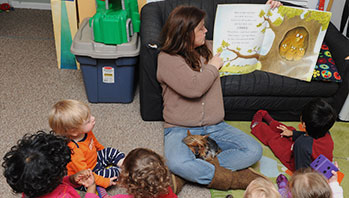- bowl of water
- chart paper
- marker
- recycled food tray
- variety of transparent plastic containers (include one clear cup, one clear bowl)
- drop
- flow
- shape
MA Standards:
Literature/RL.PK.MA.1: With prompting and support, ask and answer questions about a story or a poem read aloud.
Literature/RL.PK.MA.10: Listen actively as an individual and as a member of a group to a variety of age-appropriate literature read aloud.
Literature/RL.PK.MA.9: With prompting and support, make connections between a story or poem and one’s own experiences.
Head Start Outcomes:
Literacy Knowledge/Book Appreciation and Knowledge: Asks and answers questions and makes comments about print materials.
PreK Learning Guidelines:
English Language Arts/Reading and Literature 6: Listen to a wide variety of age appropriate literature read aloud.
English Language Arts/Reading and Literature 10: Engage actively in read-aloud activities by asking questions, offering ideas, predicting or retelling important parts of a story or informational book.
Read Together: I Get Wet #1

© Commonwealth of Massachusetts, Department of Early Education and Care (Jennifer Waddell photographer). All rights reserved.
STEM Key Concepts: Water takes the shape of its container
ELA Focus Skills: Listening and Speaking, Genre, Comprehension (Making Connections), Vocabulary
Educator Note: This is a book of simple water experiments. It can be read in segments, allowing time for children to do the activities described in each section (see “Note to the Reader” at the beginning of the book). The activity below focuses on the first activity in the book (“What shape is water?”), but you may choose to focus on another activity depending on what children are noticing in their explorations.
Educator Prep: Before reading, have on hand a pitcher of water and a few containers (one should be a clear bowl, another should be a clear cup).
Display the cover of I Get Wet. Have children locate the title. Track the words as you read the title aloud, and then have children read it with you. Splash a little bit of water on a recycled food tray. Have children observe as you describe them as water drops. Then have children look at the cover page of the book and see if they can find a water drop on the cover. Ask children what they think the book will be about. Guide children to conclude that the water drop and the words in the title are clues that this book is about water.
Before You Read
Tell children that this is a nonfiction book about water. Say, I Get Wet is a book that has a lot of information in it about water. It also has lots of experiments we can try. Tell children that today they are going to continue thinking about the idea that water has no shape of its own and do the first activity in the book. Begin by asking children:
- Where do you use water to cool off on a hot summer day?
- How do you use water to get clean after you have been playing outside?
Encourage children to think about the different shapes water takes in these situations. Ask,
- What does water look like in the pool? When it comes from the sprinkler?
- What shape is the water in the tub? In the sink? As it comes out of the shower?
Set a reading focus for children by asking them to notice the different shapes water takes in the book and to think about containers they can use to make water a different shape.
As You Read
- Pause to review children’s responses to the questions and compare them to the experiences of the boy in the book.
- As you read the pages about pouring into various containers, ask a volunteer to pour water into the same containers. Ask children to notice and describe the water’s shape in each container.
After You Read
Reread the page of text that is shaped like a plumbing pipe. Trace the words with your finger asking,
- What shape do you think the words are trying to show? (plumbing pipe)
- Why do you think the illustrator put the words in the shape of a plumbing pipe? (to show that water in a pipe takes on the shape of the pipe)
Extend children’s thinking by asking,
- What shape do you think water would be if you poured it into a round balloon?
- What shape do you think water would be if you poured it onto a flat surface without any sides?
Take It Further: Supply a variety of materials such as large straws or clear tubes, flat baking dishes, spoons, plastic gloves, ice cream cone wrappers, spherical vases, etc., for children to extend their explorations of water and how it takes the shape of any container.
